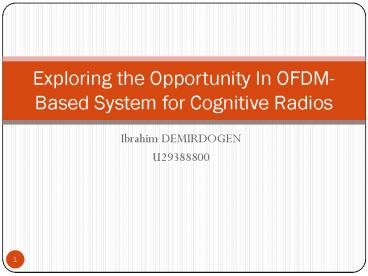Ibrahim DEMIRDOGEN
1 / 22
Title: Ibrahim DEMIRDOGEN
1
Exploring the Opportunity In OFDM-Based System
for Cognitive Radios
- Ibrahim DEMIRDOGEN
- U29388800
2
Outline
- OFDM
- Cognitive Radio
- Opportunity in OFDM System
- Simulation Results
- Conclusions
3
OFDM
- Why OFDM?
- Robust to time dispersive channel
- Efficient Spectrum Usage (Orthogonal subcarr.
positioning) - Less equalizer complexity at the receiver
- Cons
- High PAPR (Input Back Off)
- High Sidelobes (Spectral Re-growth- ACI)
- Sensitive to loss of Orthogonality
4
OFDM Cont.
- Two fundamental elements of OFDM structure are
IDFT and DFT - IDFT
- DFT
- IFFT and FFT functions of MATLAB are
implementation of these transforms in order to
have less computational complexity.
5
Cognitive Radio (CR)
- Goal
- Increase the bandwidth efficiency or spectrum
usage - How ?
- By taking advantage of vacant part of the spectrum
One day spectrum utilization of Lichtenau,
Germany, in 2001 (50 MHz- 1GHz)
6
Cognitive Radio Cont.
- Primary users(PUs) have no obligation to be aware
of secondary user - Secondary users(CRs) have to leave when PUs need
to use spectrum - Secondary users(CRs) also should not interfere
with each other. - In order to have these capability, CR should have
- Intelligence to adapt itself to environment
- Awareness of user requirements
- Awareness of resources (spectrum and power supply)
7
OFDM and CR
- OFDM meets the requirements of CR
- FFT operation eases the spectrum sensing in
frequency domain. - OFDM has adaptable parameters FFT size,
sub-carr. spacing/power, CP size, modulation - OFDM has an immunity to narrow-band
interference(turn-off) - It is interoperable with current technologies
such as (WLAN-WMAN-WPAN) - It has a support for multiuser access inherently.
(OFDMA)
8
Motivation
- How current methods affect the detection of
opportunity? - What current methods are using to find out the
opportunity? - Are current methods sufficient enough to exploit
the opportunity? - Future work
- If not, What can be done further to find out the
opportunity?
9
Exploiting the Opportunity for CR in OFDM-Based
System
- For OFDM based system, opportunity consists of
taking advantage of unused subcarriers. - How to find out the opportunity?
- Well-Known Method Searching the spectrum for
empty carriers by observing the power level of
the OFDM signal - Searching for Opportunity in OFDM
- High sidelobes mislead the opportunity detection
process - Suppress sidelobes
- Change the subcarrier allocation method
10
Sidelobe Suppression Techniques in OFDM
- Inserting Cancellation Carriers
- Increases PAPR
- Subcarrier weighting
- Increase BER and reduction is not as much as CC
- Using guard bands on both sides of the OFDM
spectrum - Using Windowing techniques before transmission
11
Subcarrier Allocation Methods
- There are two types of subcarrier allocation
methods - Block-wise subcarrier allocation
- Preferable to exploit the opportunity
- Vulnerable to channel effects
- Scattered subcarrier allocation
- More robust to channel effects
- Less number of subcarriers are detected as
opportunity
12
Simulation
- Opportunity is searched for under these
conditions and compared - Windowed vs. without Windowed OFDM signal
- Block-wise and Scatter Subcarrier Allocations
13
Simulation Parameters
- Total Subcarrier Number (N) 256
- Cyclic Prefix Size (Cp) N/4 (64)
- Window RC Window with 32 sample (16 LRC 16
RRC ) - Channel Medium Delay Spread-Vehicular B Ch.
(Most dispersive) with AWG Noise (6-Tap) - SNR Values from 10 dB to 40 dB
- Subcarr. Block Sizes L 1-2-4-8-16-32-64-128
- Numbers of employed and unemployed subcarriers
are equal which is 128
14
Some of the Simulation PlotsUsed Window- Raised
Cosine (RC)
15
RC Filtered OFDM Signal
16
Window Effect on OFDM Signal (10 dB)
17
Window Effect on OFDM Signal (20 dB)
18
Window Effect on OFDM Signal (30 dB)
19
Effect of Block Allocation Size
20
Simulation Results
- Effect of window is observed above a certain SNR
value ( 20 dB ) - Subcarrier allocation method affects the finding
out the opportunity by only looking at the power
spectrum of the signal - Windowing has less effect in scattered subcarrier
allocation - Also, definition of the threshold value has
critical importance - PFA ( detected as unused)/( used subcarriers)
should be kept minimum. - For 20 dB SNR value with a quite low PFA
- Percentage of Detected subcarriers
- 8 for L2 and 50 for L16 with windowing
- 6 for L2 and 30 for L16 without
windowing
21
Conclusions
- Sidelobes of OFDM signal effect the opportunity
detection for CR - Detection of the opportunity can be increased to
some extent by using sidelobe suppression
techniques or using block based subcarrier
assignment - Even though these techniques are used, we still
cannot fully exploit the opportunity - So, we may need to look different dimensions !!!
22
Thank You
- Questions??































